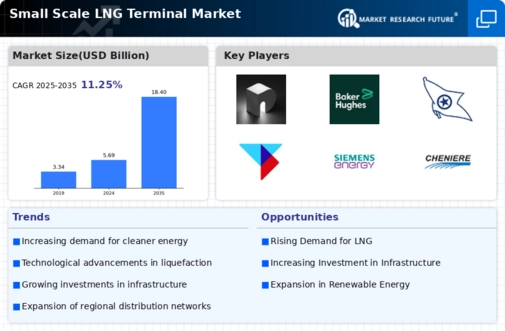Supportive Policy Frameworks
Supportive policy frameworks are playing a pivotal role in the growth of the Small Scale LNG Terminal Market. Governments are increasingly implementing policies that promote the use of LNG as a cleaner alternative to traditional fossil fuels. Incentives such as tax breaks, subsidies, and streamlined permitting processes are encouraging investments in small scale LNG infrastructure. Recent legislative measures in various regions have aimed to facilitate the development of LNG terminals, thereby fostering a favorable environment for market expansion. This supportive landscape is expected to drive further growth in the small scale LNG terminal sector.
Increasing Natural Gas Demand
The Small Scale LNG Terminal Market is experiencing a notable surge in demand for natural gas, driven by its cleaner combustion properties compared to coal and oil. As countries strive to reduce greenhouse gas emissions, natural gas is increasingly viewed as a transitional fuel. According to recent data, the demand for natural gas is projected to grow by approximately 1.5% annually over the next decade. This trend is likely to bolster the Small Scale LNG Terminal Market, as smaller terminals facilitate the distribution of LNG to remote and underserved regions, thereby enhancing energy access and supporting local economies.
Decentralization of Energy Supply
The Small Scale LNG Terminal Market is witnessing a shift towards decentralized energy supply systems. This decentralization allows for localized energy production and consumption, reducing transmission losses and enhancing energy security. Small scale LNG terminals can be strategically located to serve specific regions, thus minimizing the reliance on large, centralized facilities. This trend is particularly relevant in areas with limited infrastructure, where small scale terminals can provide a reliable energy source. The market for small scale LNG terminals is expected to expand as more regions recognize the benefits of localized energy solutions.
Investment in Infrastructure Development
Investment in infrastructure development is a critical driver for the Small Scale LNG Terminal Market. Governments and private entities are increasingly allocating funds to enhance LNG infrastructure, including small scale terminals. Recent reports indicate that investments in LNG infrastructure could reach USD 20 billion by 2027, reflecting a growing recognition of the importance of LNG in the energy mix. This influx of capital is likely to facilitate the construction of new small scale terminals, thereby expanding the market and improving access to cleaner energy sources in various regions.
Technological Innovations in LNG Processing
Technological innovations in LNG processing are significantly influencing the Small Scale LNG Terminal Market. Advances in liquefaction and regasification technologies are making small scale terminals more efficient and cost-effective. For instance, modular designs and improved cryogenic technologies are enabling faster deployment and reduced operational costs. These innovations not only enhance the economic viability of small scale terminals but also contribute to their attractiveness as a solution for meeting local energy demands. As technology continues to evolve, the market is likely to see increased adoption of small scale LNG terminals.






















